
- Home
- India
- World
- Premium
- THE FEDERAL SPECIAL
- Analysis
- States
- Perspective
- Videos
- Sports
- Education
- Entertainment
- Elections
- Features
- Health
- Business
- Series
- In memoriam: Sheikh Mujibur Rahman
- Bishnoi's Men
- NEET TANGLE
- Economy Series
- Earth Day
- Kashmir’s Frozen Turbulence
- India@75
- The legend of Ramjanmabhoomi
- Liberalisation@30
- How to tame a dragon
- Celebrating biodiversity
- Farm Matters
- 50 days of solitude
- Bringing Migrants Home
- Budget 2020
- Jharkhand Votes
- The Federal Investigates
- The Federal Impact
- Vanishing Sand
- Gandhi @ 150
- Andhra Today
- Field report
- Operation Gulmarg
- Pandemic @1 Mn in India
- The Federal Year-End
- The Zero Year
- Science
- Brand studio
- Newsletter
- Elections 2024
- Events
Parchin Kari: Why the gem-studded Mughal legacy of Taj Mahal is facing an existential crisis

Amidst the eternal allure of the Taj Mahal, the labyrinthine alleys of Taj Ganj unfold, snugly ensconced near the legendary monument. Mere minutes away from Gupta Bakery on Shri Ram Mandir Road, adjacent to Dr Shyam Lal Road in Taj Ganj, the ancestral lineage of artisans whose masterful craftsmanship brought life to the intricate marble inlays gracing the Taj Mahal unravel.The artistry, known...
Amidst the eternal allure of the Taj Mahal, the labyrinthine alleys of Taj Ganj unfold, snugly ensconced near the legendary monument. Mere minutes away from Gupta Bakery on Shri Ram Mandir Road, adjacent to Dr Shyam Lal Road in Taj Ganj, the ancestral lineage of artisans whose masterful craftsmanship brought life to the intricate marble inlays gracing the Taj Mahal unravel.
The artistry, known as Parchin Kari in Agra and Pietra dura in Italy, represents an exquisite tradition introduced to Indian soil by Persian craftsmen during the 14th century. Its legacy persists, casting a spell that transcends time, illuminating various architectural wonders from the resplendent Mughal era and beyond with its unmistakable imprint.
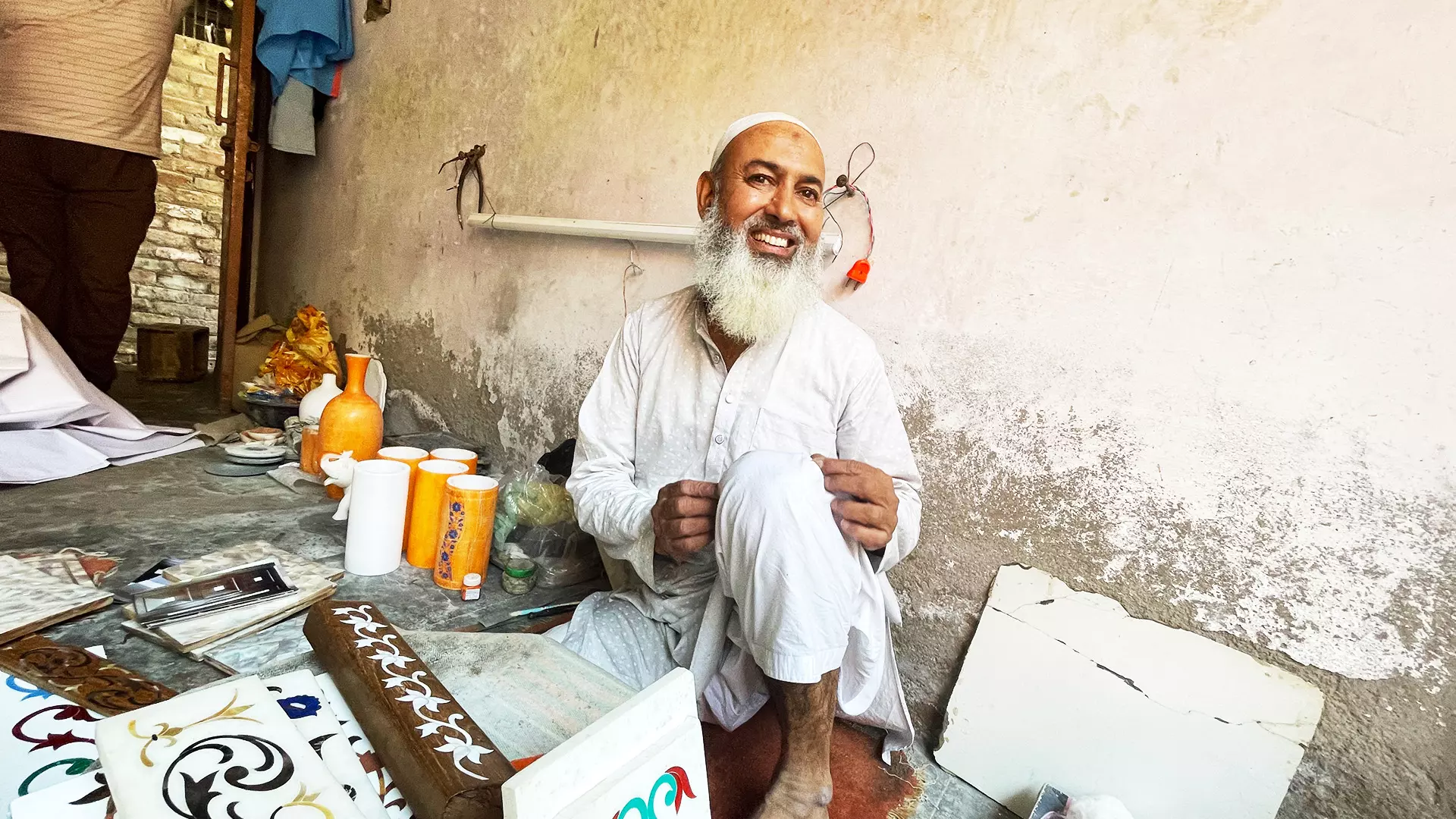
Nawaz Khan advocates for direct patronage of artists to ensure fair compensation for their labour. Photos: Veidehi Gite
Walking down the narrow road, flanked by houses painted in pink and orange, the rhythmic hum of a stone-cutting machine grows louder with each step. Finally reaching the source of the sound, amidst the hustle and bustle of a high-pitched whine and a tapping sound, the Khan family emerge into view. Asan Khan, a 43-year-old artisan, clad in a beige La Jolla t-shirt and blue track pants is deeply engrossed in his work. On the left corner of their compact workshop stands a small semi-precious stone cutter, its gleaming surface illuminated by a tubelight affixed above for optimal clarity, even under the broad daylight streaming through the room.
A plastic water bowl sits underneath, serving a dual purpose: to cleanse the freshly cut stones and to serve as a precautionary measure against mislaying. Adjacent to the workshop's entrance, a discreet backdoor hints at the connection between Khan's professional domain and his home. Khan who sits on a rough-hewn brickstone within his workshop, resonates with the weight of history as he shares his family's enduring legacy in Parchin Kari.
He traces his lineage back over 300 years, to an era when the craft flourished under the patronage of Emperor Shah Jahan. "We are the 16th generation." With a reverent tone, Khan recounts how his ancestors, from his grandfather Haji Machin to his father Haji Munna Khan, upheld the tradition of manual craftsmanship. "In those bygone days, the art of Parchin Kari knew no mechanization; every intricate detail and every smooth surface was meticulously shaped by hand," Khan tells The Federal.
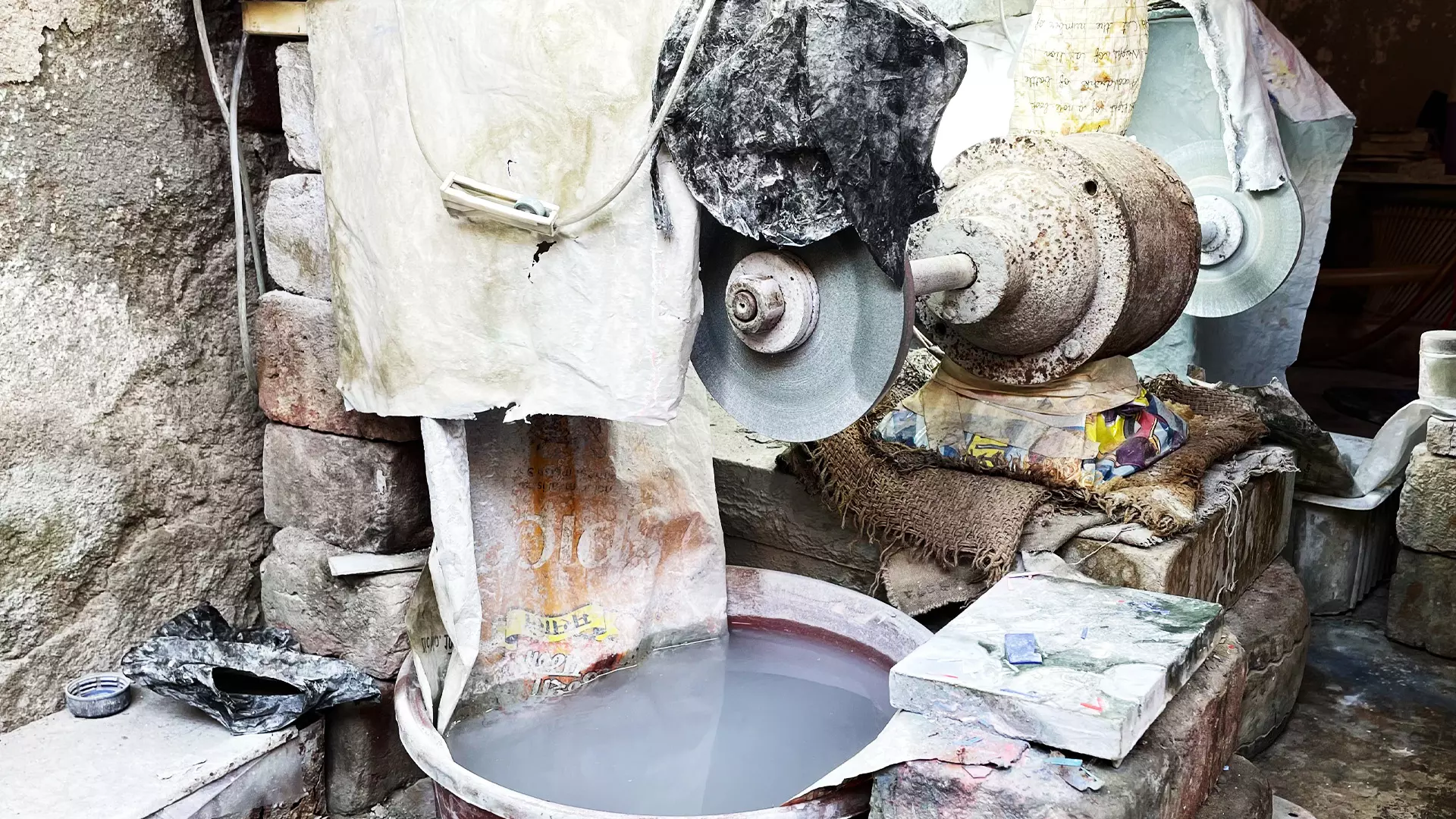
The stone-cutting machine that is used for Parchin Kari.
With a palpable sense of pride, Khan unveils a collection of weathered tools used for carving, flattening, and smoothing. As he presents each one, he imparts their purpose with a sense of familial heritage. "These are a hammer, a nail, and a chisel. we affectionately refer to them as Jharna or Jharni, and Tanki or Tinky," he says. His voice carries a note of solemnity. Khan's hands deftly navigate the worn contours of another tool, distinct yet familiar. "This, too, is a Tanki," he explains, his gaze fixed on the implement. "Though similar in name, it serves a different purpose. In our craft, we rely on four variations of Tanki and Jharni, each with its unique role." With a gentle touch, Khan singles out a Jharni from the lineup. "This one," he gestures, "is akin to a normal stone. It's instrumental in shaping and smoothing, perfect for achieving a flawless surface."
His fingers then alight upon a pointed Tanki, its tip honed to precision. "This," he reveals, "is my tool of choice for outlining the contours of the form, a delicate yet crucial step in our artistic process. In the course of my work, it's imperative to have a reserve of 10 Noks, each with a needle-pointed tip." Khan elaborates on the necessity of this precaution, noting that the fragile nature of the Noks renders them susceptible to breakage during the meticulous process of marble inlay work.
Khan gently lifted an orange marble elephant, offering it as a tangible example. With a patient smile, he explained the initial steps of the process. "Before we commence carving," he elucidated, "we coat the marble with gheru, a natural pigment reminiscent of sindoor, commonly used for painting clay pots." Asan's brother, Rizwan, interjects, grasping a bottle of vibrant orange watercolour. He says, "While watercolour dominates our palette today, Gheru was the original pigment before the advent of modern colourants."
Rizwan proceeds to reveal a collection of rough sketches on paper, offering a glimpse into their meticulous creative process. These initial designs serve as blueprints, crafted by hand before being transferred onto the smooth canvas of marble. Gesturing towards a pristine marble surface decorated with intricate patterns, he reveals the laborious effort invested in each detail. "Take this delicate flower, for instance. It has around 50 individual stones, with its centre alone boasting 8 stones," he explains with pride.

Nawaz Khan with his helper.
Rizwan elaborates on the precise methodology behind Parchin Kari, providing a step-by-step account of their craft. "First, we source finished marble from the Makhana near Jaipur, each slab presenting unique shapes and dimensions; elephants, vases, table tops and others. These marble pieces are available in white, black and grey colour only," he shares. "The pricing of each marble piece follows a straightforward metric based on its size. For instance, a small elephant-shaped marble typically fetches between Rs 3,000 and Rs 4,000, while a larger marble vase can command prices starting from Rs 10,000 and scaling upwards based on its dimensions," Asan elaborates. He further explains, "The pricing spectrum ranges from a minimum of Rs 1,500 to figures in the lakhs, reflecting the scale of the marble."
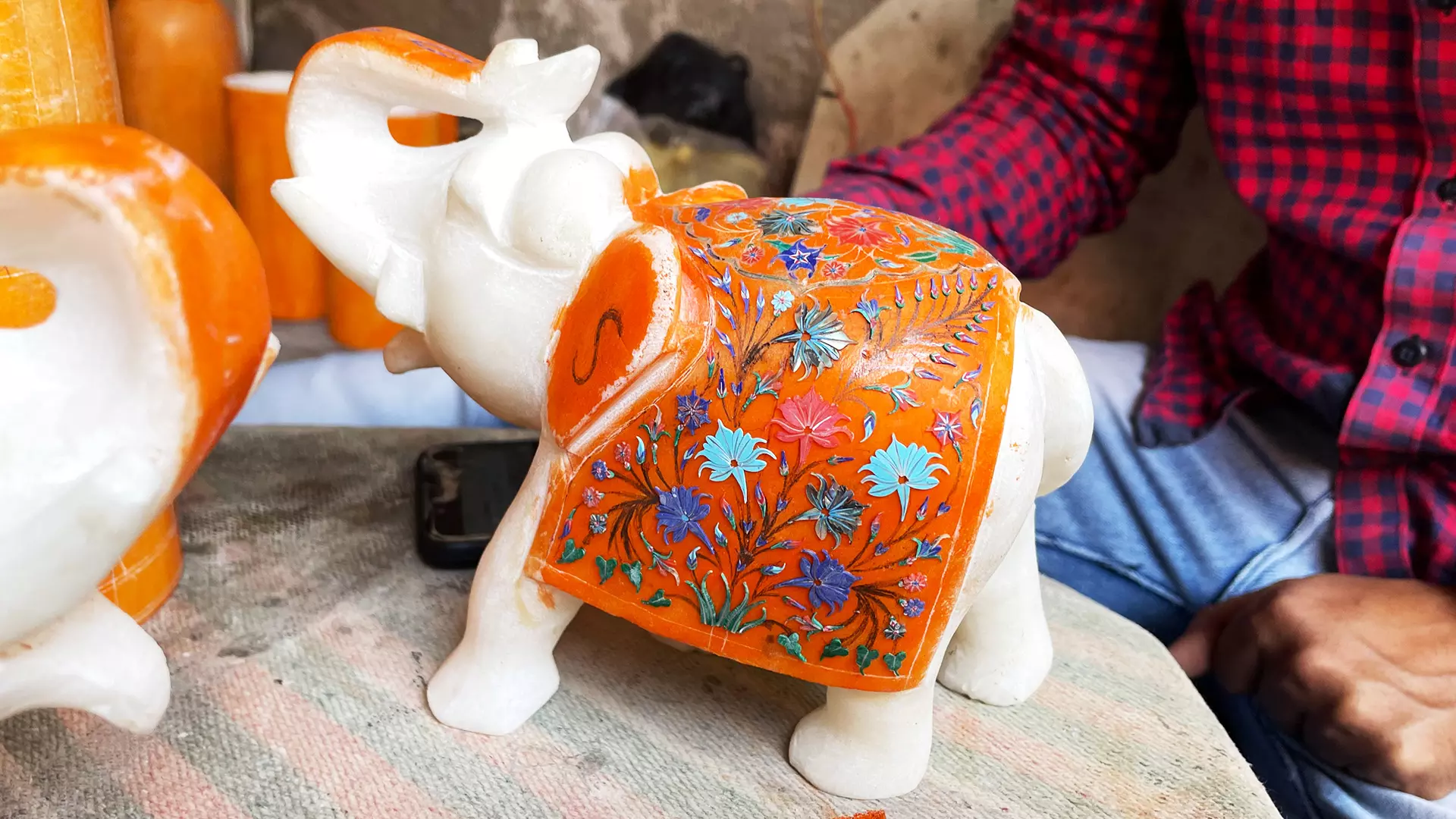
A small elephant-shaped marble typically fetches between Rs 3,000 and Rs 4,000, while a larger marble vase can command prices starting from Rs 10,000.
Rizwan adds, “In our process, we begin by applying either orange watercolour or gheru onto the marble. This step is crucial as it allows us to clearly visualise the outlines of our sketches; the pure whiteness of the marble alone doesn't provide sufficient contrast. The gerua natural colour, or orange watercolour as an alternative, dries within a mere 10 minutes. Following this, we transfer the design onto the marble by delicately carving the outlines using a pointed Tanki. Subsequently, we apply herbal glue to the carved cavities, both to fill the surface and to securely affix the semi-precious stones.” The family asserts its prerogative to safeguard the confidential recipe of this adhesive. As the intricate design takes shape, it undergoes multiple drying processes. Finally, once the entire piece is meticulously crafted and dried, they wash off the residual orange colour, revealing the pristine beauty of the finished artwork.
According to Asan, the culmination of factors such as labour, expenses tied to semi-precious stones, and transportation catapults the final pricing by a factor of ten. He says, "The elephant sculptures, fetch no less than Rs 50,000 upon completion. Even a diminutive one or two-foot marble elephant, with 5,000 pieces of semi-precious stones inlay work, demands an investment of nearly three to four months. As for the larger-scale creations, the timeline extends significantly, spanning anywhere from six months to two years."
Khan shares the monumental effort behind their largest creation to date: an impressive eight by six feet tabletop masterpiece. He says, "This grand endeavour required the meticulous labour of six skilled artisans, the incorporation of 125,000 semi-precious stones, and a span of nearly two years to reach fruition."
Intriguingly, the journey through Khan's workshop doesn't end there. Even a humble flower vase is priced at Rs 20,000, but can swiftly ascend to a remarkable Rs 3 lakh, contingent upon the intricacy and abundance of the stones meticulously embedded within.
Rizwan also sheds light on the intricate process of cutting semi-precious stones. "We got into Parchin Kari at the age of 10, honing the craft of stone cutting," Rizwan reminisces. "From coveted Lapis Lazuli to turquoise and moonga, we work with an array of semi-precious stones sourced from the market.” The process starts with buying stones approximately 3 inches in size, which are then meticulously cut to fit the envisioned designs.
Rizwan explains, “Cutting a 3-inch stone solely by machine demands a minimum of an hour, sometimes more. However, when handled manually, the laborious task extends to an exhaustive 8 to 12 hours, contingent on the desired size of the resultant pieces." The dedication to their craft becomes apparent as Rizwan reveals the effort invested in their recent masterpiece. "Take, for instance, this elephant sculpture beautified by 5000 semi-precious stones," he illustrates. "We reserved three months to grind semi-precious stones to perfection. Had we opted for manual labor, the timeline would have stretched to a formidable six to nine months."
Though the Khan family predominantly focuses on pre-designed formats, they also readily accommodate pieces tailored to their client's preferences. All they need is a picture of the design. With a nod to history, Rizwan highlights the enduring popularity of floral motifs, tracing their appeal back to the Mughal era. "Flower design is the most favourite since the time of Mughals," he asserts, emphasizing how these motifs harmonise effortlessly with semi-precious stones and other decor elements in homes today. Gesturing towards a marble piece with intricate floral patterns, Rizwan elucidates the names of various floral elements: "This is called makhli, this is chameli, this is called mochili, and this is called kali." His attention to detail extends to the foliage, as he identifies, "This is called patta," and even down to the roots of the depicted tree, "This is called merab." In seamlessly blending tradition with contemporary demand, the Khan family epitomises the enduring charm of floral motifs in decorative art.
In addition to their renowned marble décor pieces adorned with Parchin Kari, the Khan family extends their craftsmanship to framing door borders with Italian marble inlay work referred to as Pietre Dure.
Both Asan and Rizwan shed light on the diminishing practice of Parchin Kari and the challenges faced by this once-prominent art form. According to Rizwan, the future of Parchin Kari hangs precariously in the balance, with its demise looming within the next 15 to 20 years. Reflecting on its rich history, he harks back to the era of Mughal emperor Shah Jahan, the visionary behind the Taj Mahal, when approximately 150,000 artisans honed their skills in Parchin Kari. However, over time, this once-thriving tradition witnessed a steady decline, a trend exacerbated by the challenges posed by the pandemic. Presently, the practice of Parchin Kari persists only in Uttar Pradesh’s Agra, where a mere 12,000 artisans remain. Within this dwindling community, there are about 300 families, each comprising 5 to 6 artisans striving to keep this ancient craft alive amidst mounting odds.
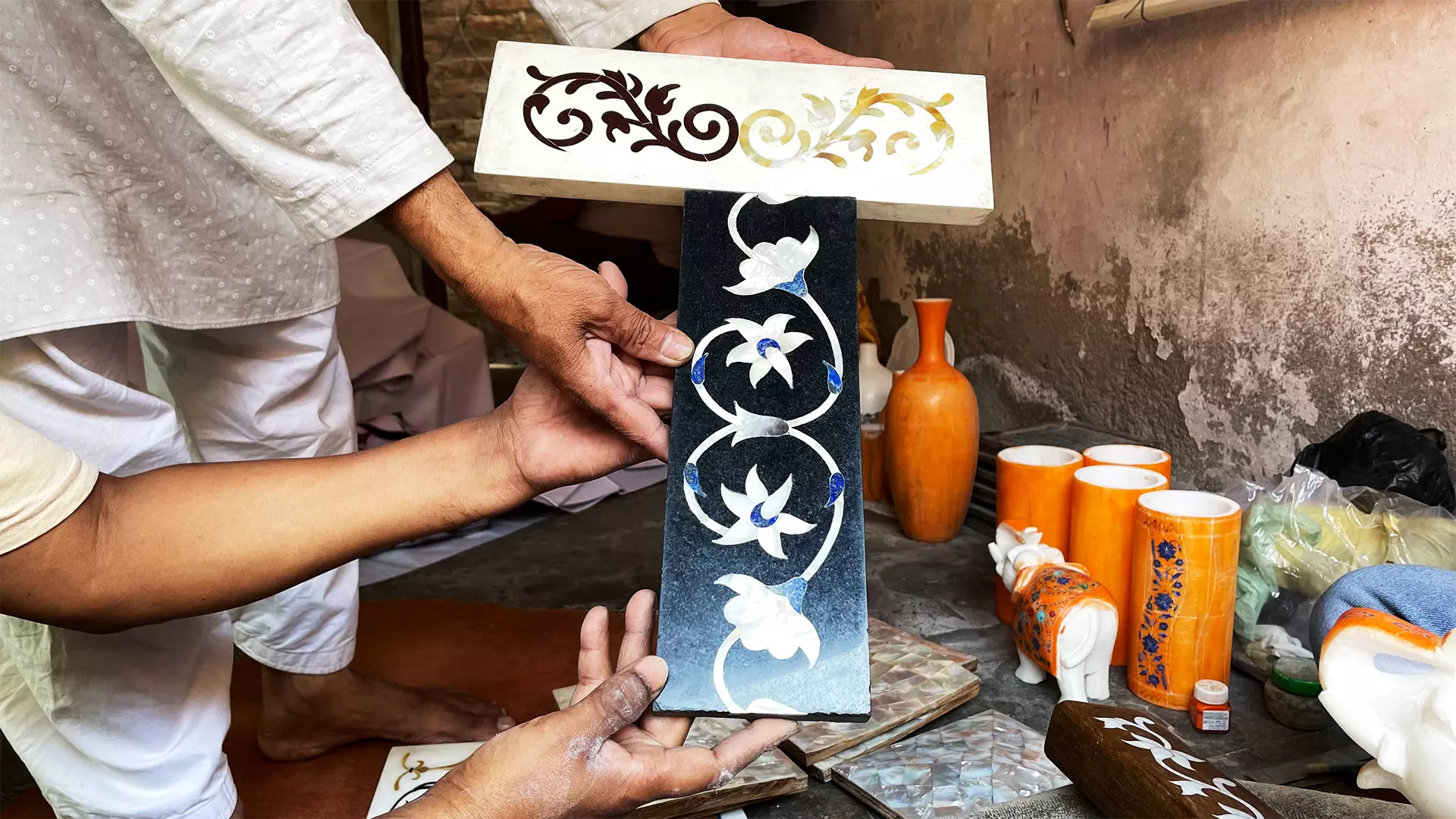
Even a humble flower vase is priced at Rs 20,000, but can swiftly ascend to a remarkable Rs 3 lakh.
When questioned about the prospect of their children carrying on the tradition of Parchin Kari, the Khans offered a resolute refusal, citing several compelling reasons. They expressed reluctance to steer their offspring towards Parchin Kari primarily due to the demanding nature of the craft, which necessitates extensive manual labour and unwavering focus. Moreover, they highlighted the inherent limitations within the profession, noting that artisans typically reach their peak productivity by the age of 45.
However, the most pressing concern voiced by the Khans pertained to the inequities within the industry's economic ecosystem. They lamented the disparity between the compensation received by artisans and the profits reaped by middlemen and retailers. Despite pouring their sweat and skill into each creation, artisans often find themselves shortchanged, as their work is undervalued in the marketplace. This glaring discrepancy, they emphasise, makes it financially untenable to sustain a livelihood solely through Parchin Kari. However, every dark cloud has a silver lining, and each adversity has a glimmer of hope.
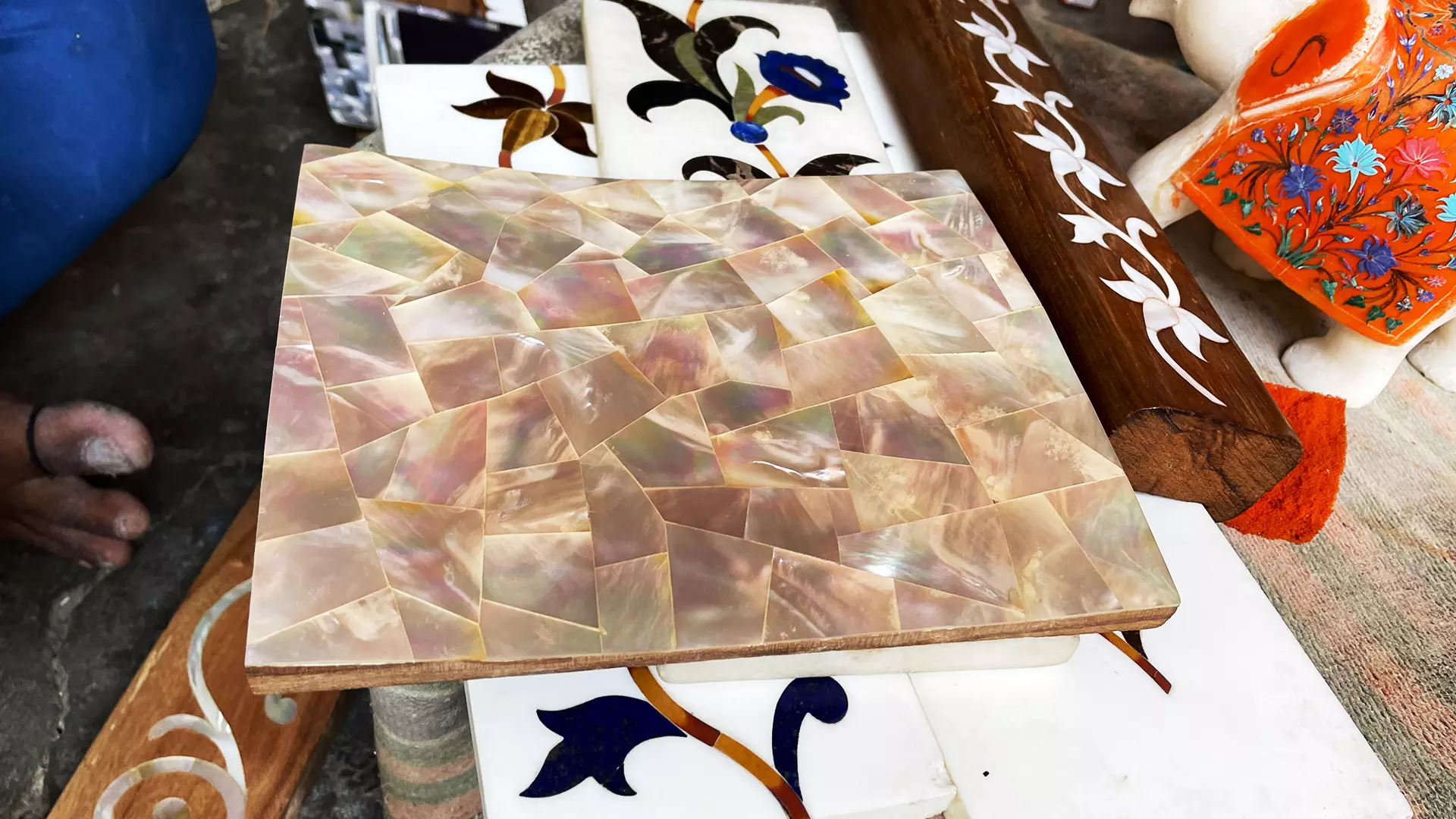
A sample of Parchin Kari.
The Tata Group, via its IHCL SeleQtions Tajview Hotel in Agra, has launched a multitude of curated experiences since the onset of 2024. These endeavours aimed at honouring traditional artisans will now acquaint guests with Agra's endangered local art forms including the exquisite craft of Parchin Kari. Manpreet Chabba, General Manager of Tajview Agra Hotel tells Federal, “Parchin Kari embellishes every corner of our hotel. Recognising the urgency of preserving this vanishing art, we've curated an immersive Seleqtion experience that not only will introduce guests to the intricacies of the craft and its production but also empower them to directly source their creations.”
The Khans, however, underscore the urgent need for a systemic shift in consumer behaviour, advocating for direct patronage of artists to ensure fair compensation for their labour. They lament the stark contrast between the illustrious past of Parchin Kari, where artisans were esteemed and remunerated with gold coins for their contributions to royal decorations, and its present-day struggle for survival. The future of Parchin Kari hangs in the balance, held captive by the irony and injustice of its economic disenfranchisement.
